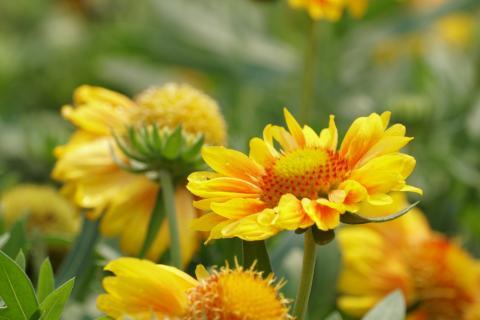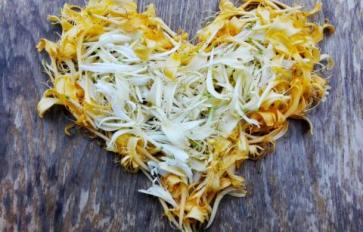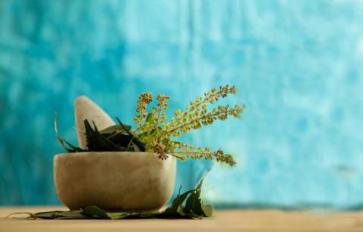
Gaillardia is a member of the family Asteraceae ⁄ Compositae or Aster family of the genus Gaillardia Foug. or blanketflower containing the species Gaillardia ×grandiflora Van Houtte [aristata × pulchella] or blanketflower. The plant is native to the western hemisphere and is one of more than two hundred plants documented by the Lewis and Clark expedition. It was named after a French magistrate Gaillard de Charentonneau whose hobby was botany and who described the flower in his 1851 book on the subject titled The Flower Garden.
The plant is also known as the Indian blanket and was designated as the state flower of Oklahoma on May 7, 1986. There is a legend about the flower that tells of an aged Native man who was famous for his red, blue, and yellow blankets. Upon his death he was wrapped in one of his blankets and the following spring, red, blue, and yellow flowers grew on his grave site.
Gaillardia is a brightly colored flower with a cone center surrounded by petals that can be red, orange, or purple in color and tipped with hues of yellow or gold. The leaves are a rich green color and have a soft, hairy texture. The plants generally mature to a height of two to three feet and have several popular varieties that include Lollypop, Burgundy, Goblin, and Golden Goblin.
How To Grow Gaillardia
Gaillardia like cool temperatures to germinate and seeds should be planted after the last frost in full sunlight and well-draining soil. They should produce flowers in the early summer depending on the variety and will last through early fall. The plants need to be watered every week to maintain moist soil and when the bed begins to look untidy cut the plants back and they will grow back fuller and produce more flowers. In the fall leave the seed heads to ensure regrowth for the next season. Every two to three years dig up the plants and re-plant them twelve to eighteen inches apart.
The plant needs a minimum of attention and to encourage flower production it is advised to deadhead the plant regularly. They are relatively free of pest infestation but they do attract aphids and leafhoppers; to keep them at bay apply soap treated with natural insect repellant or use peppermint soap. These insects carry aster yellow disease and if your blossoms remain green and do not color they are infected and should be removed.
Characteristics & Varieties Of Gaillardia
Gaillardia is an excellent plant for a butterfly garden and can be planted in a container no matter the variety. The Arizona sun grows from eight to ten inches and produces bright red-orange flowers. The fanfare grows trumpet blossoms producing deep red petals tipped with yellow around a burnt orange center and grows to a height of approximately fourteen inches. The tokajer grows to about two feet in height and produces marmalade-colored petals that hue to peach at the tip. The burgundy produces a red-wine colored blossom that has a diameter of approximately three inches and will grow to a height of up to thirty inches. The oranges and lemons variety has a more subtle hue of peach tipped in yellow with a golden center and grows to about two feet in height.
Other Interesting Facts About Gaillardia
Gaillardia flowers are grown for cutting flowers as they make an excellent addition to a floral arrangement. They are also used in landscape décor, adding color to the garden, and are easily maintained. Though the plant attracts pollinators, it repels deer. The blossoms can be dried with borax and used in a dry floral arrangement. The leaves of the gaillardia are made into an infusion and taken internally as a diuretic. Leaves made into a poultice are a treatment for gout. The seeds can be ground into seed butter for a spread on bread.








